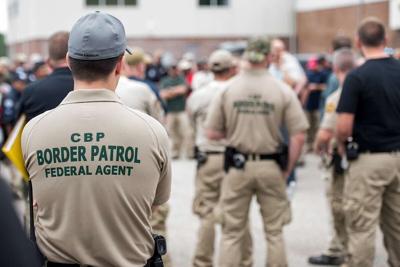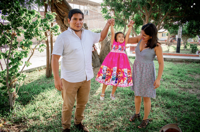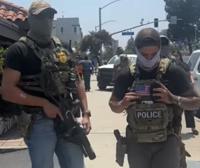
On the night of September 30, residents of a Chicago apartment building woke to the sounds of federal agents storming the building, some allegedly landing on the roof from a Blackhawk helicopter whirring above. Doors were kicked in, homes tossed, whole families—including citizens and babies—were zip-tied and marched to buses waiting outside.
One eyewitness described the scene to CNN:
“They was terrified. The kids was crying. People was screaming. They looked very distraught. I was out there crying when I seen the little girl come around the corner, because they was bringing the kids down, too, had them zip tied to each other…”
The Administration, which has already deployed National Guard troops to the city, alleges without sharing any evidence that the building was a known hangout for members of the Tren de Aragua criminal group.
Whatever the pretext, the operation makes clear that agents with Immigration and Customs Enforcement (ICE) and Customs and Border Patrol (CBP)—both under the Department of Homeland Security (DHS) and involved in the Chicago raid—now believe they can act with near total impunity, as an armed and unchecked wing of the Administration’s mass deportation agenda.
Worse yet, these tactics, first deployed in Los Angeles, have been sanctioned by the highest court in the land.
On September 9th, in Noem v. Vasquez Perdomo, the Supreme Court green lighted the detention of individuals whenever CBP agents allege they have a “reasonable suspicion” that the person is an unauthorized immigrant.
The ruling means anyone, regardless of their citizenship status, is at risk if they fit the profile. Whether in time that profile extends to anyone who falls afoul of Trump’s priorities is anyone’s guess.
The immediate consequences, meanwhile, mean virtual occupation of communities with immigrants anywhere in the country, threatening widespread sweeps, workplace raids, and the ongoing detention of community residents at bus stops, flea markets, Sunday picnics in the park.
It is nothing short of a national assault on community life, not just Los Angeles, or Portland, or Chicago, or Memphis, or Washington, DC; about one out of six people in the U.S. is an immigrant.
As White House Deputy Chief of Staff Stephen Miller recently proclaimed in Memphis, ICE agents are now “unleashed.”
What did the Supreme Court’s 6-3 decision authorize? It overturned a federal District Court’s stay blocking indiscriminate detentions based on apparent ethnicity, language, place of employment, and occupation in Los Angeles, and several other Southern California counties.
In practice, as Justice Sotomayor argued in her widely reported dissent, the ruling establishes a “second-class citizenship status for Latinos.”
Writing in defense of the ruling, issued through the court’s shadow docket—which dispenses with the usual process for hearing cases, including, for example, oral arguments, while releasing often terse, unsigned decisions—Justice Kavanaugh notes:
U.S. immigration officers have prioritized immigration enforcement in the Los Angeles area…If the officers learn that the individual they stopped is a U.S. citizen or otherwise lawfully in the United States, they promptly let the individual go.
Wrong.
One of the U.S. citizen plaintiffs in the Los Angeles case, Jason Brian Gavidia, testified that he had been stopped by a masked agent, asked if he was a U.S. citizen by another agent and after answering yes, was pushed up against a metal gated fence, had his hands put behind his back and phone confiscated, because he didn’t remember which hospital he was born in. After he showed the agents his Real ID, they kept it for 20 minutes, finally released him, and never returned it to him.
According to Mr. Gavidia, it was one of the worst experiences in his life.
Another plaintiff, Jorge Hernandez Viramontes, asked if agents in unmarked vehicles had a warrant to search the carwash where he worked. The reply that came back from the officers: “Shut the f#@k up.” Viramontes, a citizen, was taken to a warehouse and detained by the agents for several hours.
Kavanaugh goes on to argue that the citizen plaintiffs in the Los Angeles case had no basis to believe that they would be stopped again. Whether ignorance or expediency, the logic here is once again belied by facts on the ground.
Leonardo Garcia Venegas, a U.S.-born Latino citizen living in Alabama, had already been arrested twice in May in ICE sweeps of construction sites, just one of scores of reports of unlawful detentions of US citizens across the country.
Community trust in government is plummeting. Uncontrolled roving patrols of masked ICE agents in camouflage and unmarked cars, and unfounded declarations that politically targeted communities are war-torn and crime-infested are inevitably eroding public trust still further.
While the Trump Administration argued before the court that it faced an emergency and would suffer irreparable harm if ICE was restrained, the real emergency is a Supreme Court ruling making immigrant communities—and anyone who looks like an immigrant—open targets for combat-style arrest, detention, and worse.
Feature image published under CC License 1.0
This story is part of “Aquí Estamos/Here We Stand,” a collaborative reporting project of American Community Media and community news outlets statewide.










(0) comments
Welcome to the discussion.
Log In
Keep it Clean. Please avoid obscene, vulgar, lewd, racist or sexually-oriented language.
PLEASE TURN OFF YOUR CAPS LOCK.
Don't Threaten. Threats of harming another person will not be tolerated.
Be Truthful. Don't knowingly lie about anyone or anything.
Be Nice. No racism, sexism or any sort of -ism that is degrading to another person.
Be Proactive. Use the 'Report' link on each comment to let us know of abusive posts.
Share with Us. We'd love to hear eyewitness accounts, the history behind an article.